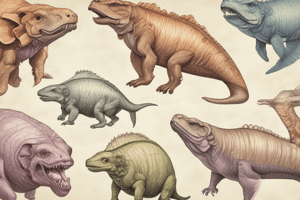Podcast
Questions and Answers
Conodont elements are composed of calcium carbonate.
Conodont elements are composed of calcium carbonate.
False (B)
The biological affinity of conodonts is still debated among scientists.
The biological affinity of conodonts is still debated among scientists.
False (B)
Conodonts are found in sediments of the Jurassic age.
Conodonts are found in sediments of the Jurassic age.
False (B)
Conodont elements range in size from 0.1 to 1.0 mm.
Conodont elements range in size from 0.1 to 1.0 mm.
The term 'conodont' refers to the mineralized skeletal structure.
The term 'conodont' refers to the mineralized skeletal structure.
The anatomy of the conodont animal is mainly known due to the well-preserved species from the Triassic of Scotland.
The anatomy of the conodont animal is mainly known due to the well-preserved species from the Triassic of Scotland.
Conodonts became extinct during the Permo-Triassic boundary extinctions.
Conodonts became extinct during the Permo-Triassic boundary extinctions.
Early ideas concluded that conodonts was a bilaterally symmetrical benthic organism.
Early ideas concluded that conodonts was a bilaterally symmetrical benthic organism.
Haptophyta is a unique division of algae that does not possess a haptonema.
Haptophyta is a unique division of algae that does not possess a haptonema.
Haptophyte algae are a minor component of marine primary producers in modern oceans.
Haptophyte algae are a minor component of marine primary producers in modern oceans.
Coccolithophores do not contribute to the sequestration of atmospheric CO2 as limestone.
Coccolithophores do not contribute to the sequestration of atmospheric CO2 as limestone.
Coccoliths are made up of silicon dioxide.
Coccoliths are made up of silicon dioxide.
Holococcoliths are composed of crystallites of varied shapes and sizes.
Holococcoliths are composed of crystallites of varied shapes and sizes.
One theory is that coccoliths act to reduce the amount of light available for photosynthesis.
One theory is that coccoliths act to reduce the amount of light available for photosynthesis.
Coccolithophores have a calcareous shell, but not a coccosphere.
Coccolithophores have a calcareous shell, but not a coccosphere.
Coccoliths range in size from about 1 to 100 μm.
Coccoliths range in size from about 1 to 100 μm.
Conodonts were suspension feeders, detritus feeders or predators.
Conodonts were suspension feeders, detritus feeders or predators.
Temperature was not an important control factor in the distribution of conodonts.
Temperature was not an important control factor in the distribution of conodonts.
Conodonts lived in colder seas and could not tolerate temperatures in excess of 30°C.
Conodonts lived in colder seas and could not tolerate temperatures in excess of 30°C.
Conodonts are not useful stratigraphic tools.
Conodonts are not useful stratigraphic tools.
The conodont color alteration index (CAI) is an indicator of thermal maturity of a source rock.
The conodont color alteration index (CAI) is an indicator of thermal maturity of a source rock.
Calcareous nannoplankton first appeared in the Paleozoic era.
Calcareous nannoplankton first appeared in the Paleozoic era.
Calcareous nannoplankton are not found in high concentrations in fine-grained pelagic sediments.
Calcareous nannoplankton are not found in high concentrations in fine-grained pelagic sediments.
Coccoliths, discoasters, and nannoconids are not types of calcareous nannoplankton.
Coccoliths, discoasters, and nannoconids are not types of calcareous nannoplankton.
Flashcards are hidden until you start studying
Study Notes
Conodonts
- Conodont elements are phosphatic tooth-like structures with affinity to an extinct early vertebrate, composed of calcium carbonate fluorapatite with additional organic matter, ranging in size from 0.25 to 2.0 mm.
- Five major functional types of conodont elements can interpret trophic characters, suggesting whether conodonts were suspension feeders, detritus feeders, or predators.
- The biological affinity of conodonts was debated, but they are now believed to be an extinct group of primitive jawless vertebrates belonging to the Chordata.
Paleoecology
- Provincialism in conodont assemblages suggests temperature was an important control factor in their distribution.
- Oxygen isotopic data indicates conodonts lived in warmer seas, tolerating temperatures above 40°C.
Applications
- Conodonts are a widespread and biostratigraphically important group of microfossils for the Paleozoic‒Triassic strata.
- The alteration of conodont elements, expressed as the “conodont color alteration index (CAI)”, is an indicator of thermal maturity of a source rock, useful in basin analysis for hydrocarbon exploration.
Calcareous Nannoplankton
- Calcareous nannoplankton, including coccoliths, discoasters, and nannoconids, represent a major component of oceanic phytoplankton, ranging in size from 0.25 to 30 μm.
- They are found in fine-grained pelagic sediments in high concentrations, with calcareous skeletons forming a significant rock-forming process.
- The first records of calcareous nannoplankton are from the Late Triassic.
Coccolithophores
- Coccolithophores are a dominant marine primary producer in modern oceans, occupying 30–50% of total chlorophyll biomass in oceans.
- They contribute to the reserve of atmospheric CO2 as limestone through sedimentation of calcified cells throughout geological time.
- Coccoliths are made up of calcium carbonate, mostly as calcite, and to a lesser extent as aragonite.
- There are two types of crystallization: heterococcoliths with varied shapes and sizes, and holococcoliths with similar types of unmodified or slightly modified rhombohedral or hexagonal crystals.
- Theories suggest coccoliths either shield the cell from excessive sunlight or concentrate light towards the interior for photosynthesis.
Studying That Suits You
Use AI to generate personalized quizzes and flashcards to suit your learning preferences.




